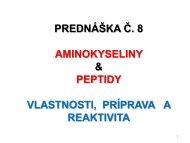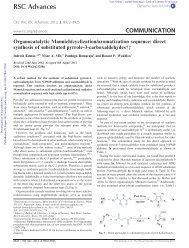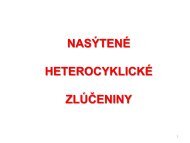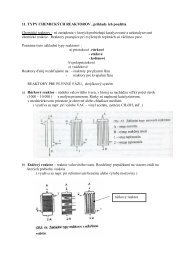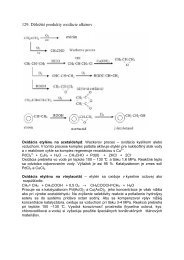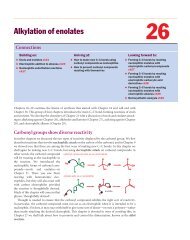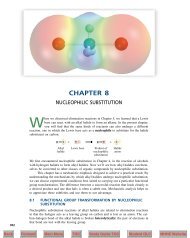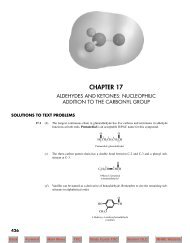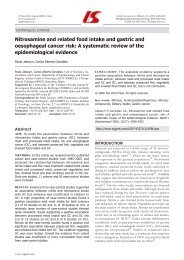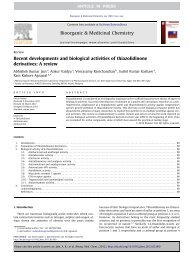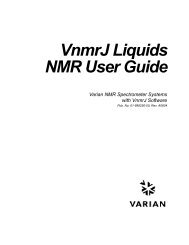Create successful ePaper yourself
Turn your PDF publications into a flip-book with our unique Google optimized e-Paper software.
Sodium azide also adds to Æ-chloroenamines 182 (NR 2 R 3 = NMe 2, pyrrolidinyl, morpholino)<br />
to give 1,2,3-triazoles 184 (via the Æ-azidoenamines 183) in good yields (Scheme<br />
64). [193,194] However, with less basic Æ-chloroenamines (NR 2 R 3 = NMePh), azirines 185 are<br />
the sole reaction products.<br />
Scheme 64 Addition of Sodium Azide to Æ-Chloroenamines [193,194]<br />
R 1<br />
Cl<br />
182<br />
NR 2 R 3<br />
R 1<br />
R 1 = Me, t-Bu, Ph<br />
183<br />
N3<br />
+ NaN 3<br />
NR 2 R 3<br />
MeCN, CCl 4<br />
R 1<br />
R 3 R 2 N<br />
R 1<br />
N<br />
185<br />
N<br />
N<br />
N<br />
NR 2 R 3<br />
R 3 R 2 N<br />
R 1<br />
N<br />
H<br />
N<br />
N<br />
184 58−84%<br />
The addition of sodium azide to (1- and 2-acylvinyl)triphenylphosphonium salts 186 and<br />
189 gives, respectively, acyl or alkoxycarbonyl-1,2,3-triazoles 188 and 191 (via the ylides<br />
187 and 190) (Scheme 65). [195,196]<br />
Scheme 65 Addition of Sodium Azide to (1- and 2-Acylvinyl)triphenylphosphonium<br />
Salts [195,196]<br />
Cl −<br />
R 1<br />
Ph3P +<br />
186<br />
O<br />
R 2<br />
NaN3, MeOH<br />
H2O R 1 = iPr, t-Bu, Cy, cyclopropyl; R 2 = H, Et<br />
X<br />
Ph3P<br />
+<br />
−<br />
189<br />
R 1<br />
Ph3P +<br />
O<br />
−<br />
187<br />
R<br />
NaN3, H2O 1 h<br />
−<br />
1<br />
O O<br />
R 1 = Me, Et, Pr, iPr, Ph, OMe<br />
FOR PERSONAL USE ONLY<br />
460 Science of Synthesis <strong>13</strong>.<strong>13</strong> 1,2,3-<strong>Triazoles</strong><br />
Ethyl 5-(4-Nitrophenyl)-1H-1,2,3-triazole-4-carboxylate (175); Typical Procedure: [187]<br />
Ph3P +<br />
CAUTION: Sodium azide can explode on heating and is highly toxic.<br />
190<br />
N3<br />
R 2<br />
N3<br />
R 1<br />
− PPh 3<br />
− PPh 3<br />
R<br />
N<br />
N<br />
N<br />
H<br />
2<br />
R<br />
188 15−50%<br />
1<br />
O<br />
N<br />
R<br />
N<br />
N<br />
H<br />
191 30−95%<br />
1<br />
O<br />
Diethyl (4-nitrobenzylidene)malonate (174; 2.0 g, 6.82 mmol) was added in one portion to<br />
a soln of NaN 3 (443 mg, 6.82 mmol) in dry DMSO (10 mL) at 258C. The mixture immediately<br />
became deep orange-brown in color and heat was evolved. After stirring for 2 h, the<br />
mixture was poured onto an ice/water slurry (40 g). The resultant mixture was extracted<br />
A. C. TomØ, Section <strong>13</strong>.<strong>13</strong>, Science of Synthesis, 2004 Georg Thieme Verlag KG



